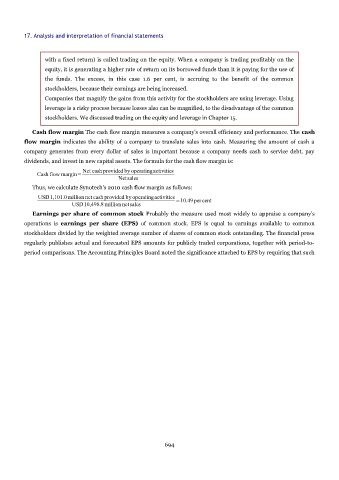Page 693 - Accounting Principles (A Business Perspective)
P. 693
17. Analysis and interpretation of financial statements
with a fixed return) is called trading on the equity. When a company is trading profitably on the
equity, it is generating a higher rate of return on its borrowed funds than it is paying for the use of
the funds. The excess, in this case 1.6 per cent, is accruing to the benefit of the common
stockholders, because their earnings are being increased.
Companies that magnify the gains from this activity for the stockholders are using leverage. Using
leverage is a risky process because losses also can be magnified, to the disadvantage of the common
stockholders. We discussed trading on the equity and leverage in Chapter 15.
Cash flow margin The cash flow margin measures a company's overall efficiency and performance. The cash
flow margin indicates the ability of a company to translate sales into cash. Measuring the amount of cash a
company generates from every dollar of sales is important because a company needs cash to service debt, pay
dividends, and invest in new capital assets. The formula for the cash flow margin is:
Net cash provided by operatingactivities
Cash flow margin=
Netsales
Thus, we calculate Synotech's 2010 cash flow margin as follows:
USD1,101.0million net cash provided by operatingactivities =10.49 percent
USD10,498.8 million netsales
Earnings per share of common stock Probably the measure used most widely to appraise a company's
operations is earnings per share (EPS) of common stock. EPS is equal to earnings available to common
stockholders divided by the weighted average number of shares of common stock outstanding. The financial press
regularly publishes actual and forecasted EPS amounts for publicly traded corporations, together with period-to-
period comparisons. The Accounting Principles Board noted the significance attached to EPS by requiring that such
694

